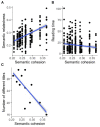Micropoetry Meets Neurocognitive Poetics: Influence of Associations on the Reception of Poetry
- PMID: 34744908
- PMCID: PMC8563571
- DOI: 10.3389/fpsyg.2021.737756
Micropoetry Meets Neurocognitive Poetics: Influence of Associations on the Reception of Poetry
Abstract
Reading and understanding poetic texts is often described as an interactive process influenced by the words and phrases building the poems and all associations and images induced by them in the readers mind. Iser, for example, described the understanding process as the closing of a good Gestalt promoted by mental images. Here, we investigate the effect that semantic cohesion, that is the internal connection of a list words, has on understanding and appreciation of poetic texts. To do this, word lists are presented as modern micropoems to the participants and the (ease of) extraction of underlying concepts as well as the affective and aesthetic responses are implicitly and explicitly measured. We found that a unifying concept is found more easily and unifying concepts vary significantly less between participants when the words composing a micropoem are semantically related. Moreover these items are liked better and are understood more easily. Our study shows evidence for the assumed relationship between building spontaneous associations, forming mental imagery, and understanding and appreciation of poetic texts. In addition, we introduced a new method well-suited to manipulate backgrounding features independently of foregrounding features which allows to disentangle the effects of both on poetry reception.
Keywords: associations; computational linguistics; literary reading; neurocognitive poetics; text comprehension.
Copyright © 2021 Hugentobler and Lüdtke.
Conflict of interest statement
The authors declare that the research was conducted in the absence of any commercial or financial relationships that could be construed as a potential conflict of interest.
Figures



Similar articles
-
Neurocognitive poetics: methods and models for investigating the neuronal and cognitive-affective bases of literature reception.Front Hum Neurosci. 2015 Apr 16;9:186. doi: 10.3389/fnhum.2015.00186. eCollection 2015. Front Hum Neurosci. 2015. PMID: 25932010 Free PMC article.
-
'Looking before and after': Can simple eye tracking patterns distinguish poetic from prosaic texts?Front Psychol. 2023 Jan 26;14:1066303. doi: 10.3389/fpsyg.2023.1066303. eCollection 2023. Front Psychol. 2023. PMID: 36777211 Free PMC article.
-
"The Boundless Realm Where All Form Lies". Representing Imagination at the Crossway Between Literary and Neurocognitive Studies.Front Integr Neurosci. 2021 Jan 29;14:618605. doi: 10.3389/fnint.2020.618605. eCollection 2020. Front Integr Neurosci. 2021. PMID: 33584213 Free PMC article.
-
Points of View and Readers' Immersion in Translation: A Neurocognitive Interpretation of Poetic Translatability.Front Psychol. 2022 May 6;13:877150. doi: 10.3389/fpsyg.2022.877150. eCollection 2022. Front Psychol. 2022. PMID: 35602720 Free PMC article. Review.
-
Psychiatric poetics: mental healthcare and Giovanni Stanghellini's 'Logics of Discovery'.BJPsych Bull. 2025 Jan 10:1-6. doi: 10.1192/bjb.2024.115. Online ahead of print. BJPsych Bull. 2025. PMID: 39789794 Review.
Cited by
-
Predicting subjective ratings of affect and comprehensibility with text features: a reader response study of narrative poetry.Front Psychol. 2024 Oct 8;15:1431764. doi: 10.3389/fpsyg.2024.1431764. eCollection 2024. Front Psychol. 2024. PMID: 39439760 Free PMC article.
References
-
- Bates D., Mächler M., Bolker B., Walker S. (2015). Fitting linear mixed-effects models using lme4. J. Stat. Softw. 67, 1–48. 10.18637/jss.v067.i01 - DOI
LinkOut - more resources
Full Text Sources

